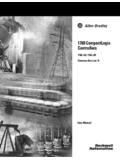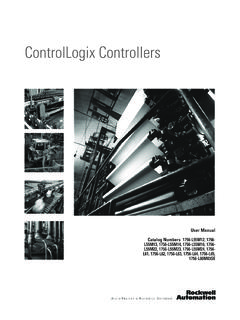Transcription of Logix5000 Controllers Messages - e-applied.com.tw
1 Logix5000 Controllers Messages Programming Manual Catalog Numbers 1756-L1, 1756-L55, 1756-L61, 1756-L62, 1756-L63, 1769- L31, 1769-L32C, 1769-L32E, 1769- L35CR, 1769-L35E, 1789-L60, 1794-L34, PowerFlex 700S/SE. Important User Information Solid state equipment has operational characteristics differing from those of electromechanical equipment. Safety Guidelines for the Application, Installation and Maintenance of Solid State Controls (publication available from your local Rockwell Automation sales office or online at ) describes some important differences between solid state equipment and hard- wired electromechanical devices. Because of this difference, and also because of the wide variety of uses for solid state equipment, all persons responsible for applying this equipment must satisfy themselves that each intended application of this equipment is acceptable. In no event will Rockwell Automation, Inc.
2 Be responsible or liable for indirect or consequential damages resulting from the use or application of this equipment. The examples and diagrams in this manual are included solely for illustrative purposes. Because of the many variables and requirements associated with any particular installation, Rockwell Automation, Inc. cannot assume responsibility or liability for actual use based on the examples and diagrams. No patent liability is assumed by Rockwell Automation, Inc. with respect to use of information, circuits, equipment, or software described in this manual. Reproduction of the contents of this manual, in whole or in part, without written permission of Rockwell Automation, Inc., is prohibited. Throughout this manual, when necessary, we use notes to make you aware of safety considerations. Identifies information about practices or circumstances that can cause an explosion in a WARNING.
3 Hazardous environment, which may lead to personal injury or death, property damage, or economic loss. IMPORTANT Identifies information that is critical for successful application and understanding of the product. Identifies information about practices or circumstances that can lead to personal injury or death, ATTENTION. property damage, or economic loss. Attentions help you identify a hazard, avoid a hazard, and recognize the consequence SHOCK HAZARD Labels may be on or inside the equipment, for example, a drive or motor, to alert people that dangerous voltage may be present. BURN HAZARD Labels may be on or inside the equipment, for example, a drive or motor, to alert people that surfaces may reach dangerous temperatures. Allen-Bradley, Rockwell Automation, and TechConnect are trademarks of Rockwell Automation, Inc. Trademarks not belonging to Rockwell Automation are property of their respective companies.
4 Table of Contents Preface Purpose of this Manual .. 5. How to Use this Manual .. 5. Chapter 1. Controller Messages Introduction .. 7. Message Queue.. 8. Cache List .. 9. Unconnected Buffers .. 10. Guidelines .. 11. Get or Set the Number of Unconnected Buffers .. 12. Get the Number of Unconnected Buffers .. 12. Set the Number of Unconnected Buffers.. 13. Convert Between INTs and DINTs .. 15. Chapter 2. Manage Multiple Messages Introduction .. 17. How to Use this Example Logic .. 17. Message Manager Logic .. 18. Initialize the Logic .. 18. Restart the Sequence, If Required.. 18. Send the First Group of MSGs.. 19. Enable the Next Group of MSGs.. 19. Send the Next Group of MSGs .. 20. Enable the Next Group of MSGs.. 20. Send the Next Group of MSGs .. 21. Chapter 3. Send a Message to Multiple Introduction .. 23. Controllers Set Up the I/O Configuration.. 24. Define Your Source and Destination Elements.
5 25. Create the MESSAGE_ CONFIGURATION Data Type .. 26. Create the Configuration Array .. 27. Get the Size of the Local Array .. 30. Load the Message Properties for a Controller .. 30. Configure the Message.. 31. Step to the Next Controller.. 33. Restart the Sequence .. 33. 3 Publication 1756-PM012B-EN-P - July 2008 3. 4 Publication 1756-PM012B-EN-P - July 2008. Preface Purpose of this Manual This manual shows how to program MSG instructions to and from Logix5000 . Controllers . This manual is one of a set of related manuals that show common procedures for programming and operating Logix5000 Controllers . For a complete list of common procedures manuals, see the Logix 5000 Controllers Common Procedures Programming Manual, publication 1756-PM001. The term Logix5000 controller refers to any controller that is based on the Logix5000 operating system, such as: CompactLogix Controllers ControlLogix Controllers DriveLogix Controllers FlexLogix Controllers SoftLogix5800 Controllers How to Use this Manual Some text is formatted differently from the rest of the text.
6 Text that is Identifies For example Means Italic the actual name of an item that you Right-click User-Defined Right-click the item that is named see on your screen or in an example User-Defined. courier information that you must supply Right-click You must identify the specific program in based on your application (a name_of_program your application. Typically, it is a name or variable) variable that you have defined. enclosed in brackets a keyboard key Press [Enter]. Press the Enter key. 5 Publication 1756-PM012B-EN-P - July 2008 5. Preface Notes: 6 Publication 1756-PM012B-EN-P - July 2008. Chapter 1. Controller Messages Introduction To transfer data between Controllers (send or receive data), execute a Message (MSG) instruction. EXAMPLE Execute a Message (MSG) Instruction If count_send = 1 and = 0 (MSG instruction is not already enabled), then execute a MSG instruction that sends data to another controller.
7 Count_send MSG. / Type - Unconfigured EN. Message Controlcount_msg .. DN. ER. This diagram shows how the controller processes MSG instructions. 1 2 Message Queue 3 Cache List 4 Unconnected Buffers Cached? MSG No 16 Yes total destination device Description 1 The controller scans the MSG instruction and its rung-condition-in goes true. The MSG instruction enters the message queue. 2 The MSG instruction comes off the queue and is processed. 3 If the MSG instruction Then the MSG instruction Does not use a connection or the connection was not previously uses an unconnected buffer to establish communication cached. with the destination device Uses a connection and the connection is cached does not use an unconnected buffer 4 Communication occurs with the destination device. 7 Publication 1756-PM012B-EN-P - July 2008 7. Chapter 1 Controller Messages Message Queue The message queue holds up to 16 MSG instructions, including those that you configure as a block-transfer read or block-transfer write.
8 When the queue is full, an instruction tries to enter the queue on each subsequent scan of the instruction, as shown below: rung-condition-in false true false .EN bit off on .EW bit off on 1 2 3 4. Description 1 The controller scans the MSG instruction. The rung-condition-in for the MSG instruction is true. The EN bit is set. The MSG instruction attempts to enter the queue but the queue is full (16 MSG instructions are already enabled). The EW bit remains cleared. 2 & 3 The controller scans the MSG instruction. The rung-condition-in for the MSG instruction is false. The EN bit remains set. The MSG instruction attempts to enter the queue but the queue is full. The EW bit remains cleared. 4 The controller scans the MSG instruction. The MSG instruction attempts to enter the queue. The queue has room so the instruction enters the queue. The EW bit is set. 8 Publication 1756-PM012B-EN-P - July 2008.
9 Controller Messages Chapter 1. Cache List Depending on how you configure a MSG instruction, it may use a connection to send or receive data. This type of message And this communication method: Uses a connection CIP data table read or write . PLC2, PLC3, PLC5, or SLC (all types) CIP. CIP with Source ID. DH+ . CIP generic your option (1). block-transfer read or write . (1) You can connect CIP generic Messages . But for most applications we recommend you leave CIP generic Messages unconnected. If a MSG instruction uses a connection, you have the option to leave the connection open (cache) or close the connection when the message is done transmitting. If you Then Cache the connection The connection stays open after the MSG instruction is done. This optimizes execution time. Opening a connection each time the message executes increases execution time. Do not cache the The connection closes after the MSG instruction is done.
10 This connection frees up that connection for other uses. The controller has these limits on the number of connections that you can cache: If you have this software Then you can cache and firmware revision or earlier Block transfer Messages for up to 16 connections Other types of Messages for up to 16 connections or later Up to 32 connections Publication 1756-PM012B-EN-P - July 2008 9. Chapter 1 Controller Messages If several Messages go to the same device, the Messages may be able to share a connection. If the MSG instructions are to And they are Then Different devices Each MSG instruction uses 1 connection. Same device Enabled at the same time Each MSG instruction uses 1 connection. Not enabled at the same time The MSG instructions share the connection. (For example, together they count as 1. connection.). EXAMPLE Share a Connection If the controller alternates between sending a block-transfer read message and a block-transfer write message to the same module, then together both Messages count as 1 connection.









